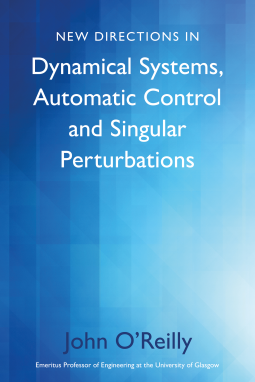
New Directions in Dynamical Systems, Automatic Control and Singular Perturbations
by John O’Reilly
This title was previously available on NetGalley and is now archived.
Send NetGalley books directly to your Kindle or Kindle app
1
To read on a Kindle or Kindle app, please add kindle@netgalley.com as an approved email address to receive files in your Amazon account. Click here for step-by-step instructions.
2
Also find your Kindle email address within your Amazon account, and enter it here.
Pub Date 14 Sep 2022 | Archive Date 14 Oct 2022
Talking about this book? Use #NewDirectionsinDynamicalSystemsAutomaticControlandSingularPerturbations #NetGalley. More hashtag tips!
Description
With this short book, Professor O'Reilly brings his considerable engineering experience to bear upon three subjects close to his heart: dynamical systems, automatic control and singular perturbations. New results of a fundamental and unifying nature are presented in all three areas. New directions are thereby established. Due care is taken of historical context and motivations. This highly readable book with its compelling physical narrative is divided into two parts, Part 1 and Part 2, for the reader’s convenience. Aimed primarily at engineers, this unusually affordable book should be read by every postgraduate.
Part 1 sets out the fundamental conditions that small-signal physically realisable dynamical system models must satisfy. These fundamental conditions are causality and non-singularity. They apply to all small-signal dynamical system models, as for example arise in electrical networks. Another important example is automatic control. Part 1 of this book also re-interprets the classic works of Nyquist and Bode to establish that the uncontrolled system must also not be singular; nor must the controlled system encounter singularity. But Part 1 goes much further. It shows that these fundamental properties, in particular non-singularity, must obtain for all small-signal system models regardless of how many inputs and outputs the system happens to have. So, small-signal automatic control for instance is all of a piece. It is that simple.
As for singular perturbations in Part 2, these little fellows simply pop up all over the place, sometimes where you least expect them. New associated low-frequency and high-frequency system transfer-function models are presented with almost insolent ease. Part 2 achieves for the frequency domain what standard singular perturbation theory does for the time domain. Moreover, even the standard nonlinear singularly perturbed system model does not escape scrutiny. Which model to choose? It could be important. Part 2 is an indispensable aid to modellers across the engineering spectrum seeking generic low-frequency and high-frequency models for what they do.
A Note From the Publisher
Available Editions
| EDITION | Ebook |
| ISBN | 9781803139494 |
| PRICE | £4.99 (GBP) |
| PAGES | 200 |



